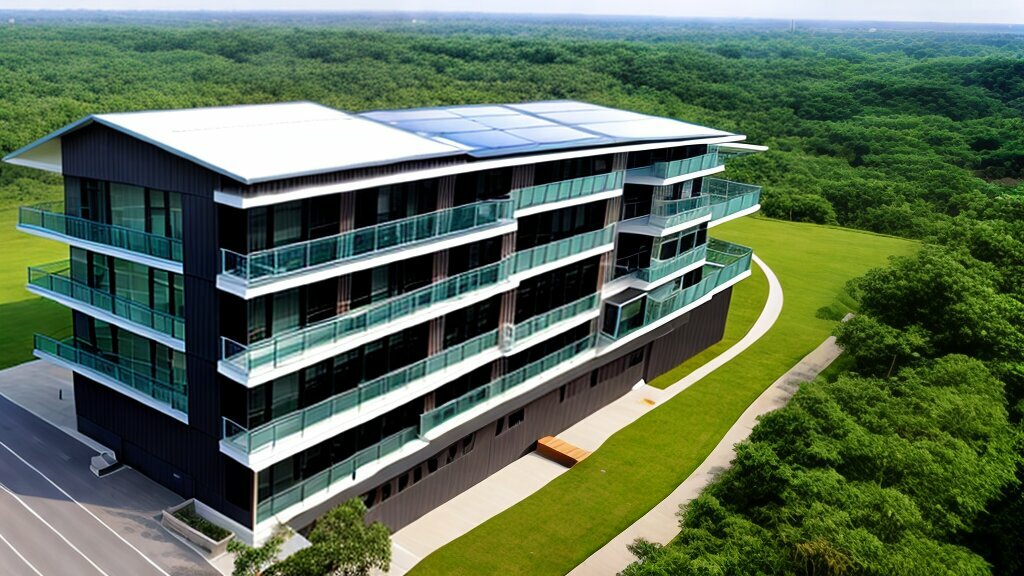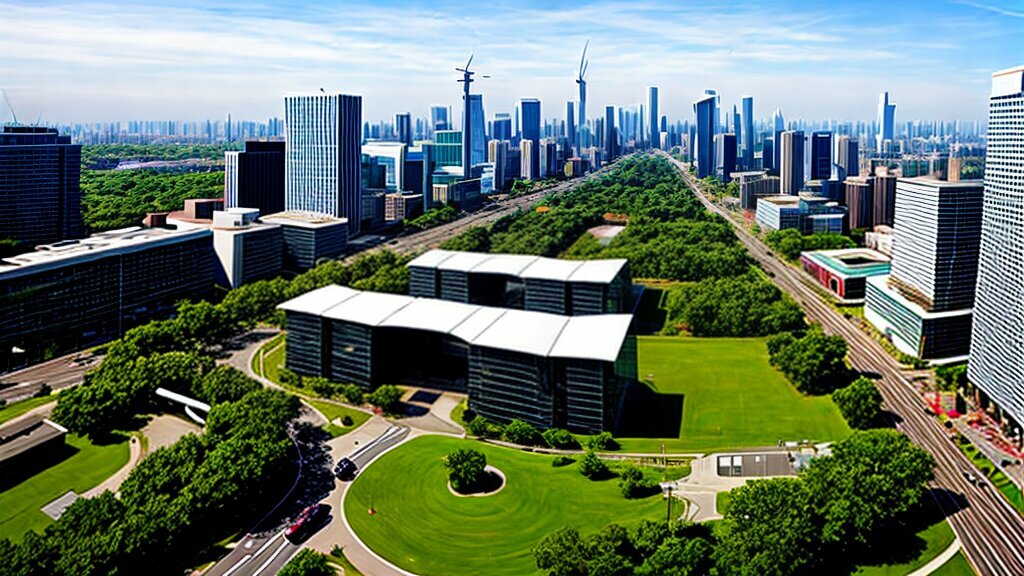Welcome to an exciting exploration of sustainable construction and its impact on shaping cities for a greener future. The rapidly growing urban population necessitates new ways of thinking about how we construct and design our cities. Sustainable urban development, green building practices, eco-friendly city planning, and sustainable architecture are all part of the solution. In this article, we will delve into the world of sustainable construction and showcase how it helps to redefine urban landscapes, creating cities that are more livable, resilient, and environmentally friendly.
Key Takeaways:
- Sustainable construction plays a vital role in shaping cities for a greener future
- Green building practices, eco-friendly city planning, and sustainable architecture are all part of the solution
- Innovative approaches to infrastructure design, such as smart cities and sustainable transportation systems, are also critical to sustainable urban development
The Importance of Sustainable Urban Development
Sustainable urban development is increasingly becoming a critical consideration for city planning and design. With population growth and urbanisation on the rise, it is vital to ensure that urban development is sustainable and eco-friendly. The concept of sustainable urban development refers to the integration of environmental, social, and economic considerations in city planning and design, with the goal of creating healthy, livable, and resilient cities that meet the needs of present and future generations.
Urban sustainability aims to balance the needs of people, the environment, and the economy, ensuring that development does not compromise the health and well-being of citizens or the natural environment. Eco-friendly city planning involves a range of strategies, such as reducing greenhouse gas emissions, promoting energy efficiency, supporting renewable energy, preserving green spaces, and reducing waste and pollution.
By incorporating sustainable practices in urban planning, cities can improve the quality of life for their citizens, enhance the natural environment, and reduce the overall environmental impact of urbanisation. In the next section, we will explore some of the benefits of sustainable urban development and the positive impact it can have on communities and the environment.

Green Building Practices: Paving the Way for Sustainable Construction
Sustainability is at the heart of modern construction, with green building practices being the cornerstone of eco-friendly city planning. These practices involve the use of renewable materials, enhancing energy efficiency, and reducing waste and carbon footprint.
Some of the key green building practices include:
| Technique |
Description |
| Passive Solar Design |
Designing buildings to naturally collect, store, and distribute solar energy for lighting, heating, and cooling purposes. |
| Green Roofs |
Roofs that are covered with vegetation, helping to reduce the amount of heat absorbed by buildings and minimize stormwater runoff. |
| Renewable Energy Sources |
Using renewable energy sources such as solar panels, wind turbines, or geothermal systems to power buildings and reduce reliance on fossil fuels. |
| Building Automation Systems |
Automating building operations such as lighting, heating, and cooling to optimize energy consumption and reduce waste. |
By incorporating these green building practices, construction projects can significantly reduce their environmental impact and contribute to building a sustainable future. Utilizing renewable materials in construction is also crucial in sustainable construction, as it reduces the depletion of natural resources and minimizes waste generation. Popular renewable materials include bamboo, recycled wood, and insulation made from recycled glass.
As sustainable construction continues to evolve, innovative techniques and technologies are emerging that can further enhance environmentally conscious building practices. For instance, construction companies are using 3D printing to create buildings using sustainable materials, which saves time and reduces waste. Advances in nanotechnology are also enabling the development of self-healing concrete, which can mitigate the need for frequent maintenance and repair work.
With sustainable construction practices becoming increasingly mainstream, they are gradually transforming urban landscapes around the globe. By prioritizing environmentally conscious building techniques and materials, we can ensure that our cities are resilient, livable, and sustainable for future generations.

Sustainable Architecture: Designing for a Sustainable Future
Sustainable architecture is a crucial element in shaping cities for a greener future. It involves designing buildings and structures that minimize their negative impact on the environment, while promoting the health and well-being of their occupants. Eco-friendly city planning is at the heart of sustainable architecture, with a focus on reducing energy consumption, minimizing waste and pollution, and using renewable resources.
Green building practices are integral to sustainable architecture, with many architects and builders adopting innovative techniques that promote sustainability. These include using renewable materials such as bamboo, recycled plastic, and salvaged wood in construction, implementing energy-efficient designs, and incorporating waste reduction strategies.
Sustainable design strategies can also enhance the livability and resilience of urban areas. Buildings designed to promote natural light, air flow, and green spaces have been shown to improve the mental and physical health of their occupants. Sustainable architecture can also help to mitigate the effects of climate change, by reducing emissions and adapting to a changing environment.
Examples of Sustainable Architecture
One notable example of sustainable architecture is the Earthship Biotecture project, founded by architect Michael Reynolds in the 1970s. The project aims to create self-sufficient, off-grid homes using recycled materials and natural resources. Another example is the Green School in Bali, Indonesia, which was built entirely from bamboo and incorporates sustainable features such as rainwater harvesting and composting toilets.

By prioritizing sustainable architecture and eco-friendly city planning, we can build a more sustainable future for our cities and communities. As architects and builders continue to explore new techniques and technologies, the possibilities for sustainable design are endless.
Sustainable Infrastructure: Building for the Future
As urban areas continue to grow, the need for sustainable infrastructure becomes increasingly important to support the needs of the population without harming the environment. Sustainable infrastructure combines innovative technologies, smart design, and green building practices to create cities that are resilient, efficient, and eco-friendly.
One key aspect of sustainable infrastructure is the development of smart cities. These cities use technology to manage and optimize resources, improve mobility, and enhance the quality of life for residents. For example, Barcelona has implemented a smart traffic management system that uses real-time data to optimize traffic flow and reduce congestion. The system also provides real-time information to drivers about available parking spaces, reducing the time spent searching for a parking spot and minimizing traffic in the city centre.
Sustainable transportation systems are another important aspect of sustainable infrastructure. Cities around the world are investing in public transportation options to reduce car usage and improve air quality. For example, in Copenhagen, more than 50% of all trips to work or school are made by bicycle, thanks to the city’s extensive cycling infrastructure. This has led to reduced traffic congestion, improved health outcomes, and reduced greenhouse gas emissions.
Energy-efficient utilities are also an essential part of sustainable infrastructure. Renewable energy sources such as wind and solar power are becoming increasingly popular, providing clean energy and reducing dependence on fossil fuels. Singapore’s Marina Bay Sands hotel and resort is a prime example of sustainable infrastructure, featuring a 2,500-panel rooftop solar system that supplies up to 7% of the resort’s energy needs.
Overall, the development of sustainable infrastructure is crucial for building cities that can support a growing population while protecting the environment. By investing in innovative technologies and green building practices, cities can become more efficient, resilient, and liveable, ensuring a better future for generations to come.
Transformative Projects: Showcasing Sustainable Construction
Real-life examples of successful sustainable construction practices can inspire and motivate others to follow suit. From innovative eco-friendly buildings to entire sustainable cities, these transformative projects showcase the possibilities and benefits of sustainable design and construction. Here are a few examples:
| Project |
Description |
| The Edge |
Located in Amsterdam, this building is considered the greenest office building in the world. It uses smart technology to optimize energy efficiency, and features solar panels, a rainwater collection system, and LED lighting. |
| One Central Park |
This residential building in Sydney, Australia uses recycled water, natural ventilation, and solar energy to reduce its environmental impact. It also boasts a stunning vertical garden system which provides shade and insulation. |
| The Crystal |
This sustainable exhibition centre in London is powered entirely by renewable energy sources, including solar, wind, and ground source heat pumps. It also features a variety of energy-efficient technologies and building materials. |
These projects demonstrate the potential of sustainable construction to create innovative and attractive buildings and spaces that benefit both people and the environment. By incorporating sustainable practices into urban planning and construction, we can build a more resilient and sustainable future for our cities.

Conclusion
In conclusion, sustainable construction practices play a vital role in shaping cities that are eco-friendly, resilient and livable for future generations. Incorporating sustainable urban development practices, such as green building techniques and sustainable architecture, not only helps reduce the environmental impact of construction but also creates spaces that are healthier and more comfortable for the community. By building sustainable infrastructure and showcasing transformative projects, we can pave the way for a greener future and a better quality of life for all. Let us all take responsibility for the future of our cities and embrace sustainable practices in every step of the construction process. Together, we can create cities that are not just beautiful but also sustainable.
FAQ
Q: What is sustainable urban development?
A: Sustainable urban development refers to the practice of planning and designing cities in a way that promotes environmental conservation, social equity, and economic vitality. It involves incorporating eco-friendly city planning principles, green building practices, and sustainable infrastructure to create cities that are environmentally friendly and livable.
Q: Why is sustainable urban development important?
A: Sustainable urban development is important because it helps create cities that are more environmentally friendly and resilient. By incorporating sustainable practices in urban planning, we can reduce energy consumption, minimize waste, and mitigate the impacts of climate change. Additionally, sustainable urban development promotes healthier and more inclusive communities, improving the quality of life for residents.
Q: What are green building practices?
A: Green building practices are techniques and strategies used in construction that prioritize environmental sustainability. These practices include using renewable materials, implementing energy-efficient designs, and reducing waste during construction projects. By adopting green building practices, we can minimize the environmental impact of construction and create buildings that are more energy-efficient and eco-friendly.
Q: How does sustainable architecture contribute to cities?
A: Sustainable architecture plays a crucial role in shaping cities. By incorporating eco-friendly city planning principles and sustainable design strategies, architects can create buildings that are energy-efficient, environmentally friendly, and resilient. Sustainable architecture enhances the livability of urban areas by providing healthier and more sustainable living spaces for residents.
Q: What is sustainable infrastructure?
A: Sustainable infrastructure refers to the development of infrastructure systems that minimize environmental impact and promote sustainable practices. This includes the design and implementation of smart cities, sustainable transportation systems, and energy-efficient utilities. Sustainable infrastructure is essential for creating cities that are more resilient, resource-efficient, and environmentally sustainable.
Q: Can you provide examples of successful sustainable construction projects?
A: There are numerous examples of successful transformative projects that embody sustainable construction practices. Some notable examples include the Zero Energy Building in Singapore, the Masdar City project in Abu Dhabi, and the Vauban neighborhood in Freiburg, Germany. These projects showcase the use of renewable materials, energy-efficient designs, and innovative construction techniques to create sustainable and eco-friendly buildings and neighborhoods.























Post comments (0)